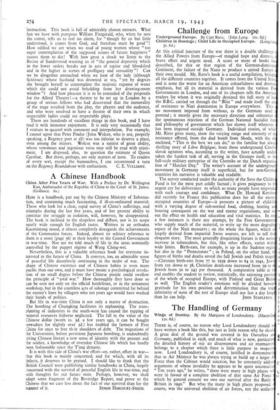Challenge from Europe
Underground Europe. By Curt Riess. (John Long. los. 6d.) Children in Bondage ; Child Life in Occupied Europe. (Long 3s. 6d.) AT this critical juncture of the war there is a double challenge t the Allied Powers from Europe—of mingled hope and distress, brave effort and urgent need. A score or more of books hat described, for this or that region of the German-dominat Continent, the failure of the Nazis to produce a united Europe their own mould. Mr. Riess's book is a useful compilation, bring all the different countries together. It comes from the United State and is none the worse for an American colourfulness and draman emphasis, but all its material is derived from the various F Governments in London, and one of its chapters tells the Amerie readers for whom it was originally destined the full story of ho the B.B.C. carried on through the " glitz " and made itself the cor of resistance to Nazi domination in Europe everywhere. This ' no movement imposed from without, as the Germans used pretend ; it merely gives the necessary direction and coherence the spontaneous rejection of the German National Socialist to and philosophy of government which has shown itself wherever has been imposed outside Germany. Individual stories, of whit Mr. Riess gives many, show the varying range and intensity of th resistance offered, from the dud bomb from Skoda, with the sl enclosed, "This is the best we can do," to the familiar but alwa thrilling story of Libre Belgique, from those underground Czech slovak agitators who, according to the writer, have actually under taken the hardest task of all, serving in the Gestapo itself, to th full-scale military enterprise of the Chetniks or the Dutch organisa tion of " Hatchet Day." The writer's account of the undergroun movement in Germany itself is superficial, but for non-Germ countries his narrative is valuable and readable.
The survey conducted under the authority of the Save the Childr Fund is for the most part coldly factual ; it gives poignancy to th urgent cry for deliverance to which so many people have responde with such courage and confidence. What Dr. Howard Kershn did recently for France this publication does for all the enemy occupied countries of Europe—it presents a picture of child-lit with a varying degree of sub-normal food, clothing, heating an housing consequent on the war and enemy requisitions, and se out the. effect on health and education and vital statistics. In onl a few instances is there any attempt, by the Free Governmen who supply much of the material, to write up the more degradin aspect of the Nazi measures ; on the whole the figures, which at largely derived from impartial Swiss sources, are left to tell the eloquent story. The most generally disquieting feature is the serio increase in tuberculosis, but this, like other effects, varies with wide limits. Birth-rate, for example, is up in the Sudeten regio but also in the "Protectorate " ; in Poland, on the other hand, ti‘ figures of births and deaths reveal the full Jewish and Polish traged —Christian birth-rate from 77 in 1939 down to 64 in 1941, Jewi from tot down to 38, Christian death-rate increased from 59 to Jewish from .5o to 243 per thousand. A comparative table at th end enables the student to review, statistically, the rationing positi of the whole of occupied Europe, with Finland and Great Brita as well. The English reader's emotions will be divided betwee gratitude for his own position and determination that the trag inferiority of most of the rest of Europe shall not last a day long


























 Previous page
Previous page